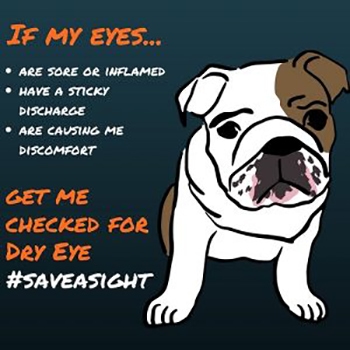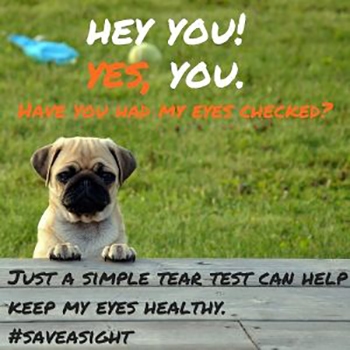FREE DRY EYE TESTS THROUGHOUT JANUARY
Preserve sight and change a life
We often take our vision for granted. Life without sight for us would be very difficult – but there is help available to guide us through our everyday lives.
But can you imagine what life without sight would be like for our canine companion? Their favourite walk or dip in the river no longer accessible. Their world shrinking.
There are many eye diseases that can lead to impaired vision. One of the most common is dry eye. It’s a progressive condition, but with correct and effective treatment the dog’s sight can be preserved, and they can continue to enjoy life to the full.
What is dry eye?
 Dry eye, also known as Keratoconjunctivitis Sicca (KCS), is a condition where the tear glands do not produce enough tears to meet the needs of the eye. About 1 in 22 dogs is affected by dry eye¹ and 1 in 5 of predisposed breeds², such as pugs and cavalier King Charles spaniels. The disease is most often due to the body’s immune system attacking and destroying the tear glands.
Dry eye, also known as Keratoconjunctivitis Sicca (KCS), is a condition where the tear glands do not produce enough tears to meet the needs of the eye. About 1 in 22 dogs is affected by dry eye¹ and 1 in 5 of predisposed breeds², such as pugs and cavalier King Charles spaniels. The disease is most often due to the body’s immune system attacking and destroying the tear glands.
Tears are essential to lubricate and nourish the eye, and to prevent infections. When tear levels are low, eyes can start to feel itchy and uncomfortable (like having grit in them), and can be covered in a thick discharge. The pet may also suffer from recurrent conjunctivitis. Once the disease has progressed, deep ulcers may quickly develop on the surface of the eye.
This can be extremely painful, and can result in the need to surgically treat or even remove the eye. Dry eye is a progressive and irreversible condition which can lead to blindness if untreated, so the sooner it is detected and treatment started, the better the long-term outlook for the dog’s vision and comfort.
What are the signs of dry eye?
It is important to know that dogs affected by dry eye may initially appear normal, even if there has been significant destruction to the tear glands and decreased tear production. The signs to look out for include:
• ‘Sore’ eyes that may look red or inflamed
• Uncomfortable eyes – e.g. rubbing the eyes, keeping the eyes closed, squinting, excessive blinking or general restlessness
• Discharge from the eyes – this is often thick and green to yellow in colour
• Dry or dull looking eyes
• Obvious blood vessels on the eye surface
• A dark colour (pigment) on the surface of the eye
• Frequent eye infections or ulcers
Why is dry eye so important?
Dry eye is irreversible and if untreated, can progressively reduce vision leading to blindness. When the eye is
dry, blood vessels start to grow across the surface of the eye, where pigment is deposited. This can lead to the
surface of the eye (the cornea) becoming thicker and less transparent, reducing vision. Without tears, the eye’s
ability to fight and prevent infection is dramatically reduced, and vision-threatening ulcers can quickly develop.
Dry eye is also uncomfortable and painful, with some dogs becoming extremely restless and unable to
concentrate on anything else.
Why does dry eye occur?
There are many reasons that dry eye can occur, however by far the most common is the body’s own immune
system attacking the tear glands. Why this happens, we aren’t always sure!
Which pets are at risk of dry eye?
Any dog can get dry eye; however, some breeds are at a higher risk. These include:
• English Cocker Spaniels
• Bulldogs
• Lhasa Apsos
• West Highland White Terriers
• Shih-Tzus
• Cavalier King Charles Spaniels
• Yorkshire Terriers
• Pugs
Due to their increased risk, extra vigilance is needed with these breeds to detect dry eye early. Prompt treatment can help to ensure vision and comfort are preserved. Yearly screening at vaccination can be a helpful and easy
way to detect the condition early. Please ask if you would like us to do this.
How can we detect dry eye?
We can measure dogs’ tear production in only 60 seconds using a Schirmer Tear Test. This involves a special piece of paper being placed in the corner of the eye, which measures tear output and provides immediate results. No sedation or anaesthetic is required and most dogs tolerate the test extremely well.
How can we treat dry eye?
Treatment is aimed at preventing further destruction of the tear glands and stimulating them to produce more tears. This can be done using eye drops that dampen down the inflammation in the eye and prevent the immune
system attacking the gland.
Synthetic tears can also be given to improve lubrication and comfort, however tears alone are not sufficient to prevent further destruction of the tear gland and preserve vision. Synthetic tears do not contain all the important components of real tears, and are not available continuously like real tears. It is therefore essential that medication is used to encourage the tear glands to produce their own tears and to prevent further destruction. Regular monitoring is also important to ensure comfort and effective treatment. As dry eye is a
permanent disease, treatment must be lifelong to help preserve vision.
 We hope you have found this article useful. If you have any further questions or are concerned your dog may be at risk of dry eye, please contact us to arrange an appointment. Early detection and effective treatment is the best way to preserve and maintain your dog’s vision! Share this article with your friends and help #saveasight
We hope you have found this article useful. If you have any further questions or are concerned your dog may be at risk of dry eye, please contact us to arrange an appointment. Early detection and effective treatment is the best way to preserve and maintain your dog’s vision! Share this article with your friends and help #saveasight
References:
1. Pierce V & Williams D. Determination of Schirmer Tear Test values in 1000 dogs. BSAVA Abstract 2006.
2. Williams D, Mann B. A Crosslinked HA-Based Hydrogel Ameliorates Dry Eye Symptoms in Dogs. International
Journal of Biomaterials. Volume 2013, Article ID 460437.




